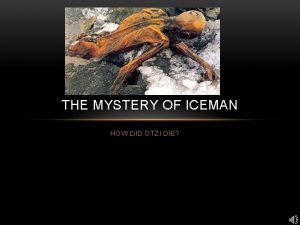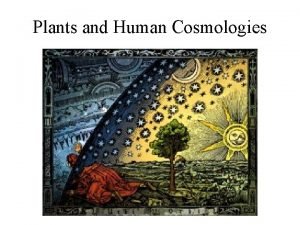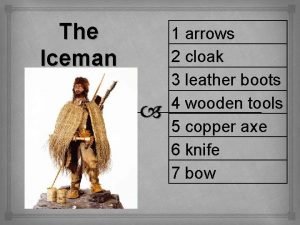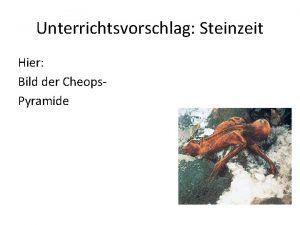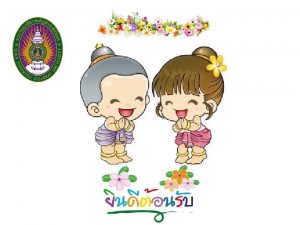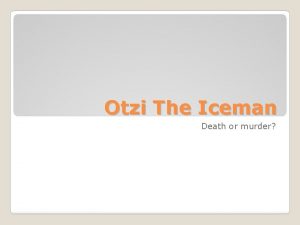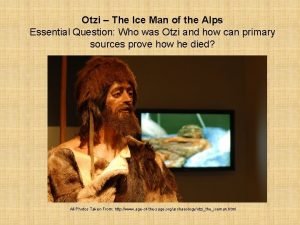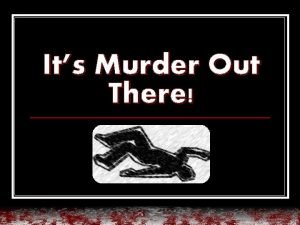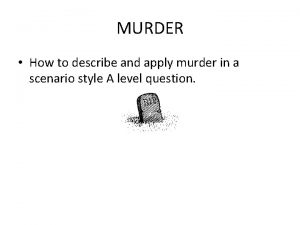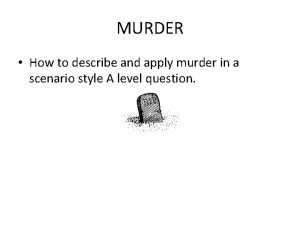CSI Otzi the Ice Man Death murder in
















- Slides: 16

CSI: Otzi the Ice Man Death (murder? ) in the Tyrolean Alps

Exhibit #1 Location and general view of the discovery site. The body was found at an elevation of 11, 000 ft. Approximately 5000 ft from the valley floor.

Exhibit #2 The Iceman’s survival kit: a flint stone knife and a copper ax.

Exhibit #3 Arrow heads of flint stone, unfinished arrows, and a deerskin quiver.

Exhibit #5 Exhibit #4 The body was found lying face down on a rock.


Exhibit: #5 An arrowhead was found embedded in his left shoulder. There was a cut in the palm of his right hand into two of his fingers, damaging the tendons. It was inferred that he was holding a blade.

Exhibit #6: Medical Evidence • • • • • At the time of death he was forty-six (46) years old He was 5’ 2” tall and weighed 110 pounds Ötzi would have worn a men’s size 5 ½ shoe His body arms and chest were crisscrossed with old scars He had at one time broken his nose He had three ribs that had been recently broken, meaning at the time of his death Ötzi would have been in a great deal of pain Ötzi had a severely degenerated left knee, hip and ankle which would have made walking both painful and difficult X-rays indicated Ötzi had a bad back probably caused by the degeneration of spinal disks He had “smoker lung” Analysis of pollen, dust grains and the isotopic composition of his tooth enamel indicates that he spent his childhood near the present village of Feldthurns, north of Bolzano, but later went to live in valleys about thirty miles further north He was missing five upper incisors Deep furrows on his finger nails showed signs of chronic illness and stress to his immune system Ötzi had severe plaque buildup in his arteries and was suffering from coronary heart disease He had man-made scars cut in straight lines around his shoulders, ankles and knees Pollen in the first meal showed that it had been consumed in a mid-altitude pine forest, and other pollens indicated the presence of wheat which must have been planted crops from the valley below Diatoms (ancient skeletons of algae) in Ötzi's intestines identified the exact river he had drunk from eight hours before his death Analysis of Ötzi's intestinal contents showed two meals (the last one consumed about eight hours before his death), one of mountain goat meat (Ibex), the other of red deer and baked herb bread

Exhibit #7 This axe was made of wood and copper. The craftsman was highly skilled. Someone carrying this axe would have had high importance in a society. The axe was right next to Otzi when he was found.

Exhibit #8 Otzi had over sixty tattoos made of fire soot then scratched under the skin. Most of Ötzi’s tattoos are located on parts of his body that must have caused him pain during his lifetime due to degeneration or disease.

Exhibit # 9: Biological evidence Three grains of Ostrya carpinifolia (Hophornbeam) pollen magnified 1600 x. Wheat spiklets derived from Einkorn grain, stuck to the Iceman's clothing. The same material was found in the iceman’s intestine indicating that he had eaten a hard bread shortly before his death. The plant material came from an agricultural area. The majority of the pollen came from the hop hornbeam tree, which grows in a warm environment. The hop hornbeam tree blooms between March and June, and because the sperm inside the pollen grain, which normally decays after a short exposure to air or water, was still intact, it had to have been absorbed relatively soon after its release from the tree. The nearest stands of that tree could have grown to the south of the Hauslabjoch, at least five or six hours away by foot. The high valleys to the north are just too cold to sustain it.

Exhibit #10 Otzi had the back of his skull just above his neck fractured. There is evidence that there was brain hemorrhaging due to this fracture.

Exhibit #11 • Ötzi's clothes were sophisticated. • • He wore: cloak made of woven grass and a coat a belt, a pair of leggings a loincloth made of leather of different skins. • He also wore a bearskin cap with a leather chin strap. • Shoes made of bearskin for the soles, deer hide for the top panels, and a netting made of tree bark. Soft grass went around the foot and in the shoe and functioned like modern socks.

CSI: Report Names____________ Who was Otzi? (Daily Life, Occupation, etc. ) Evidence From Exhibits What was Otzi doing high up in the Mountains? Evidence From Exhibits How did Otzi die? Evidence From Exhibits

What are 10 things we can learn about the people living in the European Alps during the Mesolithic Period? • • • -




